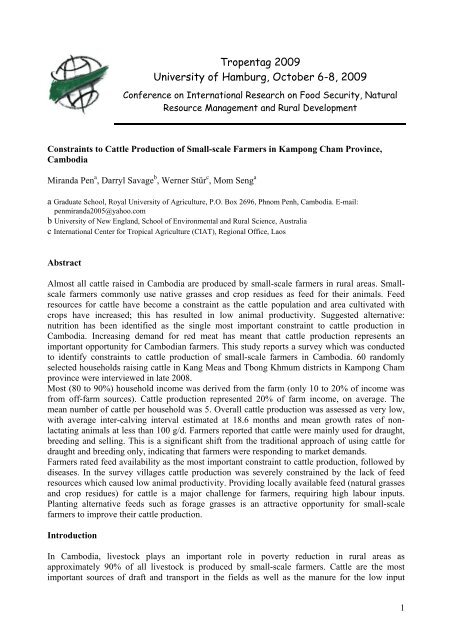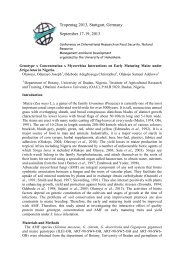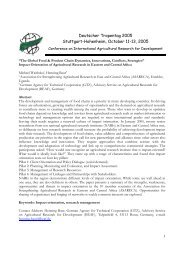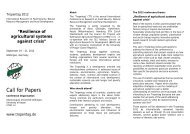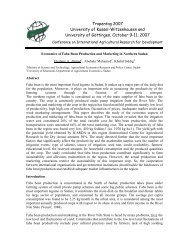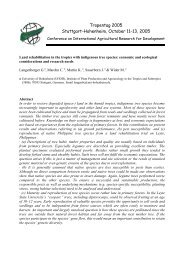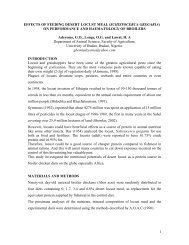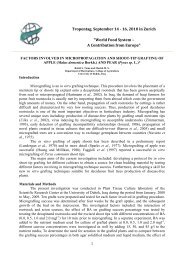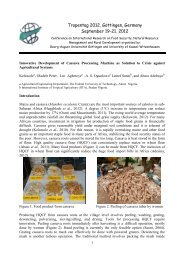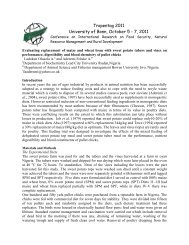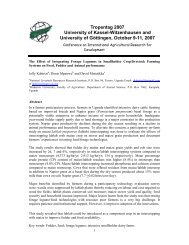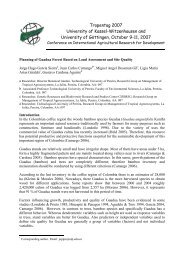Constraints to Cattle Production of Small-scale Farmers ... - Tropentag
Constraints to Cattle Production of Small-scale Farmers ... - Tropentag
Constraints to Cattle Production of Small-scale Farmers ... - Tropentag
Create successful ePaper yourself
Turn your PDF publications into a flip-book with our unique Google optimized e-Paper software.
<strong>Tropentag</strong> 2009<br />
University <strong>of</strong> Hamburg, Oc<strong>to</strong>ber 6-8, 2009<br />
Conference on International Research on Food Security, Natural<br />
Resource Management and Rural Development<br />
<strong>Constraints</strong> <strong>to</strong> <strong>Cattle</strong> <strong>Production</strong> <strong>of</strong> <strong>Small</strong>-<strong>scale</strong> <strong>Farmers</strong> in Kampong Cham Province,<br />
Cambodia<br />
Miranda Pen a , Darryl Savage b , Werner Stür c , Mom Seng a<br />
a Graduate School, Royal University <strong>of</strong> Agriculture, P.O. Box 2696, Phnom Penh, Cambodia. E-mail:<br />
penmiranda2005@yahoo.com<br />
b University <strong>of</strong> New England, School <strong>of</strong> Environmental and Rural Science, Australia<br />
c International Center for Tropical Agriculture (CIAT), Regional Office, Laos<br />
Abstract<br />
Almost all cattle raised in Cambodia are produced by small-<strong>scale</strong> farmers in rural areas. <strong>Small</strong><strong>scale</strong><br />
farmers commonly use native grasses and crop residues as feed for their animals. Feed<br />
resources for cattle have become a constraint as the cattle population and area cultivated with<br />
crops have increased; this has resulted in low animal productivity. Suggested alternative:<br />
nutrition has been identified as the single most important constraint <strong>to</strong> cattle production in<br />
Cambodia. Increasing demand for red meat has meant that cattle production represents an<br />
important opportunity for Cambodian farmers. This study reports a survey which was conducted<br />
<strong>to</strong> identify constraints <strong>to</strong> cattle production <strong>of</strong> small-<strong>scale</strong> farmers in Cambodia. 60 randomly<br />
selected households raising cattle in Kang Meas and Tbong Khmum districts in Kampong Cham<br />
province were interviewed in late 2008.<br />
Most (80 <strong>to</strong> 90%) household income was derived from the farm (only 10 <strong>to</strong> 20% <strong>of</strong> income was<br />
from <strong>of</strong>f-farm sources). <strong>Cattle</strong> production represented 20% <strong>of</strong> farm income, on average. The<br />
mean number <strong>of</strong> cattle per household was 5. Overall cattle production was assessed as very low,<br />
with average inter-calving interval estimated at 18.6 months and mean growth rates <strong>of</strong> nonlactating<br />
animals at less than 100 g/d. <strong>Farmers</strong> reported that cattle were mainly used for draught,<br />
breeding and selling. This is a significant shift from the traditional approach <strong>of</strong> using cattle for<br />
draught and breeding only, indicating that farmers were responding <strong>to</strong> market demands.<br />
<strong>Farmers</strong> rated feed availability as the most important constraint <strong>to</strong> cattle production, followed by<br />
diseases. In the survey villages cattle production was severely constrained by the lack <strong>of</strong> feed<br />
resources which caused low animal productivity. Providing locally available feed (natural grasses<br />
and crop residues) for cattle is a major challenge for farmers, requiring high labour inputs.<br />
Planting alternative feeds such as forage grasses is an attractive opportunity for small-<strong>scale</strong><br />
farmers <strong>to</strong> improve their cattle production.<br />
Introduction<br />
In Cambodia, lives<strong>to</strong>ck plays an important role in poverty reduction in rural areas as<br />
approximately 90% <strong>of</strong> all lives<strong>to</strong>ck is produced by small-<strong>scale</strong> farmers. <strong>Cattle</strong> are the most<br />
important sources <strong>of</strong> draft and transport in the fields as well as the manure for the low input<br />
1
farming system and income <strong>to</strong> the household when selling mature <strong>of</strong>fspring. Nearly all cattle are<br />
produced by smallholder farmers in rural areas using native grass and crop residue as the<br />
common feed for their animal. This habit is becoming a constraint for them when the number <strong>of</strong><br />
animals and cultivated area is increased as this result in a shortage <strong>of</strong> feed resources (Stür and<br />
Horne, 1999 and 2001). Nutrition has been identified the most single problem <strong>to</strong> reduce the<br />
productivity <strong>of</strong> cattle in smallholder system.<br />
Kampong Cham province accounts for 13% <strong>of</strong> cattle population <strong>of</strong> Cambodia and has the great<br />
potential for cattle development with small-<strong>scale</strong> farmers. In 2003, the use <strong>of</strong> forage fodder banks<br />
was introduced by CIAT through the Livelihood and Lives<strong>to</strong>ck Systems Project in this province.<br />
Research <strong>to</strong> increase cattle productivity <strong>of</strong> small-holder farmers in Cambodia, is carried out by<br />
the project “Improved Feeding Systems for More Efficient Beef <strong>Cattle</strong> <strong>Production</strong> in Cambodia”<br />
(Forage for Beef project) which is funded by the Australian Center for International Agriculture<br />
Research from 2008 <strong>to</strong> 2011 (ACIAR, 2008).<br />
This study is a part <strong>of</strong> the current project with the aim <strong>to</strong> identify the constraints <strong>to</strong> cattle<br />
production <strong>of</strong> small-<strong>scale</strong> farmers in Kampong Cham province. The results <strong>of</strong> this study will be<br />
used <strong>to</strong> provide a comparison for later impact assessment.<br />
Material and Methods<br />
Two districts <strong>of</strong> Kampong Cham province were selected as the research sites for this study: Kang<br />
Meas and Tbong Khmum. Thmey Kor village located in Roka Koy commune in Kang Meas<br />
district was chosen as research site 1 and Chroy Ko village located in Chiro Pi commune in<br />
Tbong Khmum district as research site 2. A list <strong>of</strong> all households in each survey site has been<br />
assembled with the help <strong>of</strong> the chief <strong>of</strong> village, showing which households raise cattle and which<br />
households have already planted forages. 60 farmers were randomly selected from the list (30<br />
from each village) <strong>to</strong> be interviewed using semi-structured questionnaires in late 2008.<br />
Results and Discussion<br />
The findings show that more land was available for the farmers in Tbong Khmum district <strong>to</strong> be<br />
owned than the farmers in Kang Meas district. As shown in Table 1, the farmers in Tbong<br />
Khmum had on average 2.9 ha <strong>of</strong> land per household while the farmers in Kang Meas owned<br />
only 1.06 ha (P = 0.001). The land is an important resource <strong>of</strong> the farmers <strong>to</strong> invest the<br />
agriculture in their household. The annual income <strong>of</strong> the farmers was 1912 and 3296 USD in<br />
Kang Meas and Chroy Ko respectively (significantly different at P = 0.008). Most <strong>of</strong> the<br />
household income (more than 80%) <strong>of</strong> farmers was derived from farm activities. <strong>Cattle</strong><br />
production represented almost 20% <strong>of</strong> the household income.<br />
Table 1: Household information <strong>of</strong> farmers<br />
Variables Kang Meas Tbong Khmum Total P-value<br />
Average land area (ha) 1.06 2.90 1.98 0.001<br />
Average income (USD) 1912 3296 2604 0.008<br />
% <strong>of</strong> income from farm activities 80 87 83 0.295<br />
% <strong>of</strong> income from <strong>of</strong>f-farm activities 20 13 17 0.281<br />
% <strong>of</strong> income from cattle 17 19 18 0.603<br />
The cattle production <strong>of</strong> small-holder farmers was not found <strong>to</strong> be different in these two districts<br />
(Table 2). The mean number <strong>of</strong> cattle per household was 4.3 and 5.3 heads in Kang Meas and<br />
Tbong Khmum respectively. Many farmers kept not only male cattle, but also 1-3 heads <strong>of</strong><br />
2
female cattle per household. Most <strong>of</strong><br />
cattle were kept as breeding animal,<br />
especially female cattle, <strong>to</strong> produce the<br />
calf for selling (Figure 1). Besides this<br />
purpose, cattle were also used for draft<br />
power and being sold <strong>to</strong> market. More<br />
farmers in Kang Meas used their cattle<br />
for draft power while more farmers in<br />
Tbong Khmum kept their cattle for sale.<br />
Percentage<br />
60<br />
50<br />
40<br />
30<br />
20<br />
10<br />
Overall, the reproductive performance<br />
Draught Breeding Sale<br />
<strong>of</strong> cattle was very low in terms <strong>of</strong> age at<br />
first pregnancy and calving interval Figure 1: <strong>Cattle</strong> production purpose <strong>of</strong> farmers<br />
(Table 2). The heifers <strong>of</strong> small-holder farmers in the studied villages started the first calving at 3<br />
years <strong>of</strong> age. Then the average calving interval <strong>of</strong> the cows was approximately 18.6 months. The<br />
reproductive performance is an important trait in cattle production. The cow should have their<br />
first calf at early age and have minimum calving interval. According <strong>to</strong> Roy et al. (1975), the<br />
normal heifers reach the first puberty at age between 320 and 600 days. The best calving interval<br />
<strong>of</strong> cows is 12 month which is required <strong>to</strong> rebreed the cattle at 80 days after calving, but most<br />
cows do not reach this point (Kunkle et al., 1998). The poor nutritional status is the main fac<strong>to</strong>r <strong>to</strong><br />
prolong the anoestrus <strong>of</strong> cow (Perry et al., 1991; Lalman et al., 1997).<br />
0<br />
Kang Meas<br />
Tbong Khmum<br />
Table 2: Number <strong>of</strong> cattle and their reproductive performance<br />
Variables Kang Meas Tbong Khmum Total P-value<br />
Number <strong>of</strong> cattle (heads) 4.3 5.3 4.8 0.23<br />
Number <strong>of</strong> cow (heads) 1.6 2.3 1.9 0.037<br />
Age at first calving (years) 2.8 3.1 2.9 0.155<br />
Calving interval (months) 17.2 19.6 18.6 0.055<br />
The farmers in the studied sites rated the lack <strong>of</strong> feed and disease as the most constraints <strong>to</strong> cattle<br />
production. The lack <strong>of</strong> feeds occurred almost all year long as the grasses s<strong>to</strong>pped growing in dry<br />
season and the land was become cultivated area in rainy season. Moreover, in some area as the<br />
case <strong>of</strong> Kang Meas, most <strong>of</strong> area was<br />
flooded during flooding season which<br />
limited the grazing land for animal. As a<br />
result, feeding cattle required high labor<br />
input, more than 6 hours per day per<br />
household on average. As shown in<br />
Table 3, member <strong>of</strong> household including<br />
children spent on average 4.5 hours per<br />
day far from home for grazing their<br />
cattle which was almost available in dry<br />
season. During the time which native<br />
grasses were available, especially in<br />
rainy season, farmers spent on average<br />
2.5 hours per day <strong>to</strong> collect those native<br />
Percentage<br />
from the field. For farmers who planted forage around or near their house, they spent less than 0.5<br />
hours <strong>to</strong> cut and carry those forage for their cattle. Besides theses activities, farmers also spent<br />
almost 1 hour <strong>to</strong> clean, give water <strong>to</strong> animal and manage the manure. The lack <strong>of</strong> feed and<br />
diseases were also the main constraints for cattle production <strong>of</strong> farmers in others provinces <strong>of</strong><br />
Cambodia (Windsor, 2008). During the scarcity <strong>of</strong> feeds, cattle feeding are mainly based on the<br />
100<br />
80<br />
60<br />
40<br />
20<br />
0<br />
Lack <strong>of</strong><br />
feed<br />
Disease Market<br />
issue<br />
Veterinary<br />
service<br />
Figure 2: Main problems for cattle production <strong>of</strong> farmers<br />
3
crop residue such as rice straw which has very low quality. Poor nutrition results in low growth<br />
rate (less than 100 g/d) and low reproductive performance.<br />
Table 3: Average time spent for cattle feeding and management<br />
Activities (h/day) Kang Meas Tbong Khmum Total P-value<br />
Grazing 4.6 4.4 4.5 0.756<br />
Collecting native grass 2.4 2.6 2.5 0.661<br />
Cutting planted forage 0.25 0.4 0.3 0.169<br />
Cleaning and watering 0.6 0.4 0.5 0.155<br />
Manure management 0.4 1 0.7 0.345<br />
Conclusions<br />
The cattle production shared almost 20% <strong>to</strong> the household income <strong>of</strong> small-<strong>scale</strong> farmers in rural<br />
areas. However, it was severely constrained by the lack <strong>of</strong> feeds resource. This problem may have<br />
a prolonged impact on the reproductive performance <strong>of</strong> cattle. Providing locally available feeds<br />
(natural grasses and crop residues) <strong>to</strong> cattle is a major challenge for farmers in rural areas,<br />
requiring high labor inputs. As a result, farmers had <strong>to</strong> spend more than 6 hours per day <strong>to</strong> feed<br />
and manage their cattle. Planting alternative feeds such as forage grasses is an attractive<br />
opportunity for small-<strong>scale</strong> farmers <strong>to</strong> improve their cattle production. The technical departments<br />
should provide technical assistance and forage planting materials <strong>to</strong> farmers <strong>to</strong> grow the forage on<br />
their farm. The researches <strong>to</strong> improve cattle feeding system should be done <strong>to</strong> provide<br />
recommendations <strong>to</strong> farmers.<br />
References<br />
1. Australian Center for International Agricultural Research (ACIAR) (2008). Improved<br />
feeding systems for more efficient beef cattle production in Cambodia. Project overview.<br />
2. Lalman, D. L., D. H. Keisler, J. E. Williams, E. J. Scholljegerdes, and D. M. Mallet. (1997).<br />
Influence <strong>of</strong> postpartum weight and body condition change on duration <strong>of</strong> anestrus by<br />
undernourished suckled beef heifers. J. Anim. Sci. 75:2003-2008.<br />
3. Perry, R. C., Corah, L. R., Cochran, R. C. Beal, W. E., Stevenson, J. S., Min<strong>to</strong>n, J. E.,<br />
Simms, D. D. and Brethour, J. R. (1991). Influence <strong>of</strong> dietary energy on follicular<br />
development, serum gonadotropins, and first postpartum ovulation in suckled beef cows. J.<br />
Anim. Sci. 69:3762-3773.<br />
4. Roy, J.H.B., Gillies, C.M. and Shot<strong>to</strong>n, S.M. (1975). Fac<strong>to</strong>rs affecting first oestrus in cattle<br />
and their effects on early breeding. In: J.C. Tayler (Eds.). The early calving <strong>of</strong> heifers and its<br />
impact on beef production. Commission <strong>of</strong> the European Communities, Brussels, pp. 128-<br />
142.<br />
5. Stür, W.W. and Horne, P.M. (1999). Forage technology development with small-holder<br />
farmers – How <strong>to</strong> best varieties <strong>to</strong> <strong>of</strong>fer farmers in Southeast Asia. ACIAR monograph No.<br />
62. 80 pages. CIAT, Vientiane, Laos.<br />
6. Stür, W.W. and Horne, P.M. (2001). Developing forage technology with small-holder<br />
farmers – How <strong>to</strong> grow, manage and use. ACIAR monograph No. 88. 96 pages. CIAT,<br />
Vientiane, Laos.<br />
7. Windsor, P., (2008). Identifying research priorities for development <strong>of</strong> the beef industry in<br />
Cambodia and Lao PDR with special reference <strong>to</strong> animal health interventions. Final report<br />
published by ACIAR. Australia.<br />
4


